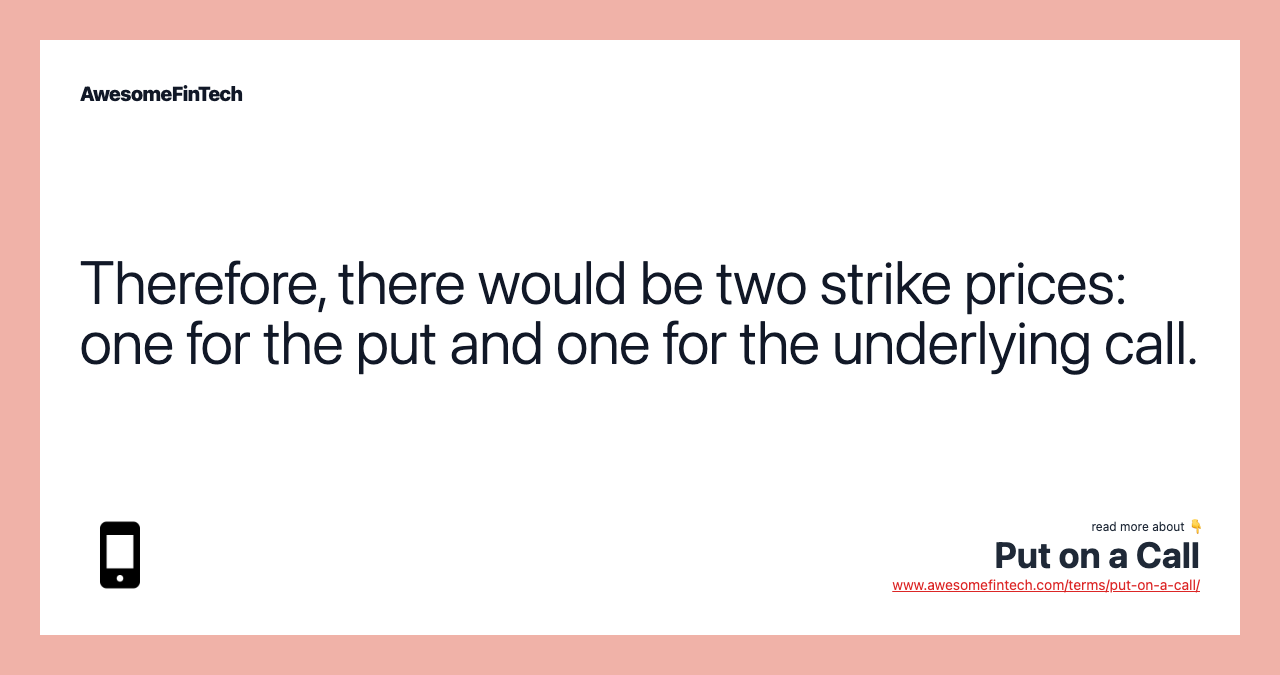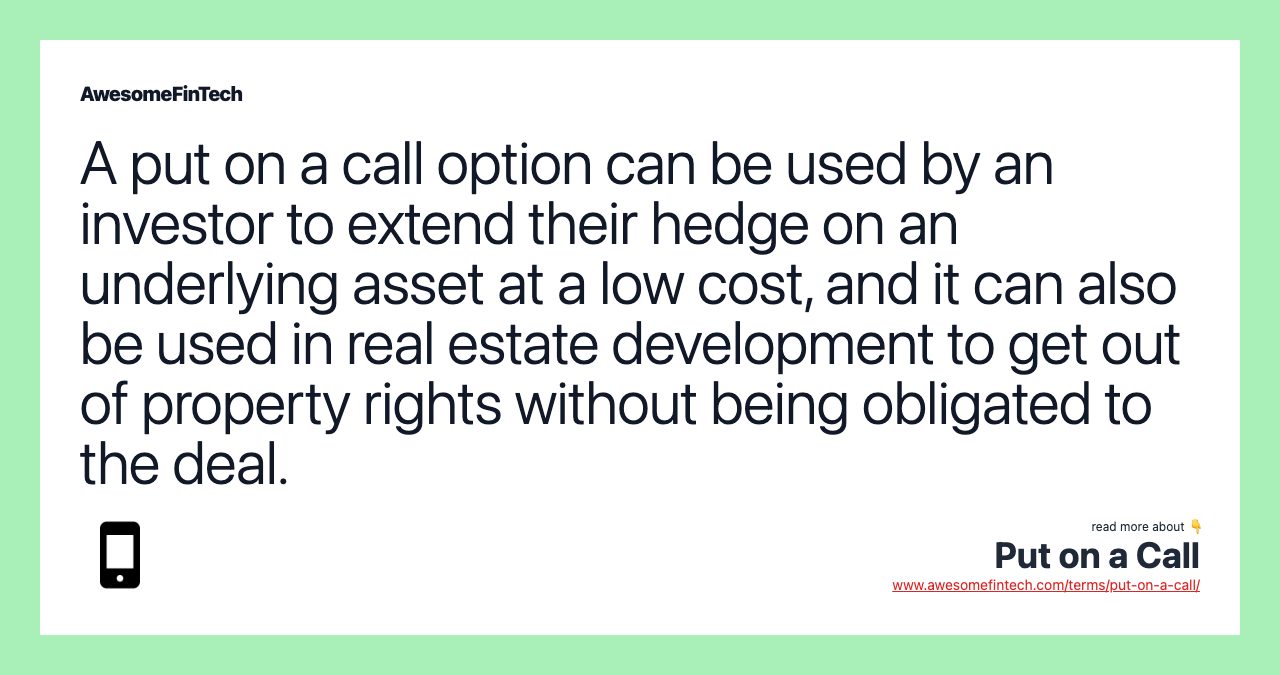Put on a Call
A put on a call (PoC) is a type of compound option whereby a put option is written on a call option. A put on a call option is a compound option that gives the holder the right to sell a call option Therefore, there would be two strike prices: one for the put and one for the underlying call. A put on a call option can be used by an investor to extend their hedge on an underlying asset at a low cost, and it can also be used in real estate development to get out of property rights without being obligated to the deal. When the holder exercises a put on a call, called the overlying option, they must then deliver the underlying call option to the seller and collect a premium based on the strike price of the overlying put option. When the holder exercises a compound call option, called the overlying option, they must then pay the seller of the underlying option a premium based on the strike price of the compound option. Alternatively, when the holder exercises a compound call option, they must pay the seller of the underlying option a premium based on the strike price of the overlying call option. If the option owner exercises the put option they will be short a call option, which is an option that gives the owner the right but not the obligation to buy a specific asset at a set price within a defined time period.

What Is a Put on a Call?
A put on a call (PoC) is a type of compound option whereby a put option is written on a call option. Therefore, there are two strike prices and two exercise dates.
If the option owner exercises the put option they will be short a call option, which is an option that gives the owner the right but not the obligation to buy a specific asset at a set price within a defined time period.
The value of a put on a call changes in inverse proportion to the stock price. This means the value decreases as the stock price increases and increases as the stock price decreases. A put on a call may also be known as a split-fee option.



How a Put on a Call Works
When the holder exercises a put on a call, called the overlying option, they must then deliver the underlying call option to the seller and collect a premium based on the strike price of the overlying put option. This premium is called the back fee.
Alternatively, when the holder exercises a compound call option, they must pay the seller of the underlying option a premium based on the strike price of the overlying call option.
It is more common to see compound options in currency or fixed-income markets, where uncertainty exists regarding the option's risk protection capabilities. The advantages of compound options are that they allow for large leverage and they are cheaper than straight options. However, if both options are exercised, the total premium will be more than the premium on a single option.
In the mortgage market, PoC options are useful to offset the risk of interest rate changes between the time a mortgage commitment is made and the scheduled delivery date.
Real-World Application
While speculation in the financial markets will always be a major portion of compound option activity, business enterprises might find them useful when planning or bidding on a large project. In some cases, they must secure financing or supplies before actually starting or winning the project. If they do not build or win the project they could be left with financing they do not need. In this case, compound options provide an insurance policy.
The same is also true for institutions providing the financing as they seek to hedge their exposure should if they commit to providing the money needed by businesses for their projects and those businesses do not win their deals.
Compound Options
A compound option is an option for which the underlying asset is another option. Therefore, there are two strike prices and two exercise dates. They are available for any combination of calls and puts. For example, a put where the underlying is a call option or a call where the underlying is a put option.
The following compound options are available:
When the holder exercises a compound call option, called the overlying option, they must then pay the seller of the underlying option a premium based on the strike price of the compound option. This premium is called the back fee. Alternatively, when the holder exercises a compound put option, they must deliver the underlying option to the seller of the compound option.
Traders may use compound options to extend the life of a bearish options position since it is possible to buy a put with a shorter time to expiration for another put with a longer expiration. In other words, they can participate in the losses of the underlying without putting up the full amount to buy it at expiration. The caveat is that there are two premiums paid and a higher cost.
It is more common to see compound options in currency or fixed-income markets, where uncertainty exists regarding the option's risk protection capabilities. The advantages of compound options are that they allow for large leverage and they are cheaper than straight options. However, if both options are exercised, the total premium will be more than the premium on a single option.
Related terms:
Back Fee
The back fee is the premium paid for the second option in a compound option, or the premium paid to extend certain exotic options. read more
Call on a Call
A call on a call is a type of compound option that gives the holder the right to buy a different plain vanilla call option on the same underlying security. read more
Call on a Put
A call on a put refers to a compound option where there is a call option on an underlying put option. read more
Call Option
A call option is a contract that gives the option buyer the right to buy an underlying asset at a specified price within a specific time period. read more
Compound Option
A compound option is an option for which the underlying asset is another option, thus two strike prices and two exercise dates. read more
Fixed Income & Examples
Fixed income refers to assets and securities that bear fixed cash flows for investors, such as fixed rate interest or dividends. read more
Front Fee and Example
The front fee is the option premium paid by an investor upon the initial purchase of a compound option. A compound option is an option on an option. read more
Leverage : What Is Financial Leverage?
Leverage results from using borrowed capital as a source of funding when investing to expand a firm's asset base and generate returns on risk capital. read more